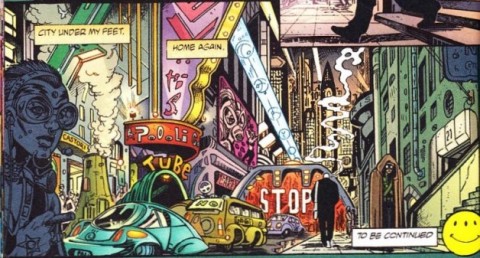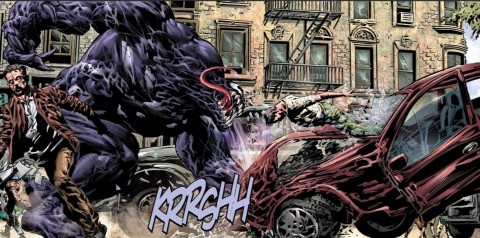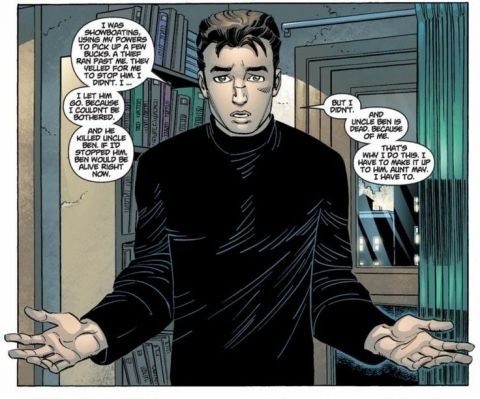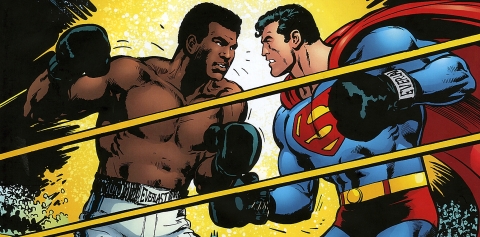52 weeks. 52 different writers. 2 trade paperbacks or hardcovers a week. Each week I’ll take a look at a different writer and read two different collected editions from within that person’s repertoire to help in the examination of their work.
Warren Ellis has written for seemingly every major publisher at one point or another. His work is often laced with sociopolitical tinges as well as dashes of technological talk. There is no finer example of this sort of work from Ellis than his series from the early 1990’s called Transmetropolitan. Althought it was intially an unsuccessful series, publishing the first year of stories under the Helix imprint, Transmetropolitan remained a critical darling and gained a cult following as it switched over to Vertigo.
Transmetropolitan Vol 1: Back To The City
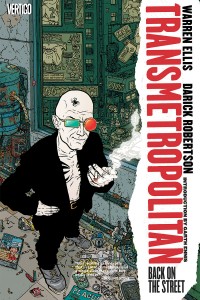 After five years of exile in the Mountains, Spider Jerusalem gets a rude awakening from his serene life of seclusion. A former journalist, Spider gets an unexpected phone call from his former editor informing him that, as per his contract, he still needs to produce two more books or get sued for everything he’s worth and then some. Spider begrudgingly leaves the Mountain and returns to the thriving technological hub known as the City, a place he loathes more than anything in the entire world. Spider knows it’s necessary for him to live and survive in the City if he’s ever to succeed as a writer again since it’s the only place he’s actually capable of writing in. After quickly gaining a job and means to survive in the City again, Spider sets out to shine a whole new wicked type of light on to all types of topic throughout the City, highlighting religion, politics, mass media, and “gender issues”.
After five years of exile in the Mountains, Spider Jerusalem gets a rude awakening from his serene life of seclusion. A former journalist, Spider gets an unexpected phone call from his former editor informing him that, as per his contract, he still needs to produce two more books or get sued for everything he’s worth and then some. Spider begrudgingly leaves the Mountain and returns to the thriving technological hub known as the City, a place he loathes more than anything in the entire world. Spider knows it’s necessary for him to live and survive in the City if he’s ever to succeed as a writer again since it’s the only place he’s actually capable of writing in. After quickly gaining a job and means to survive in the City again, Spider sets out to shine a whole new wicked type of light on to all types of topic throughout the City, highlighting religion, politics, mass media, and “gender issues”.
Transmetropolitan is that series you never really knew you needed to read until after you read it. It’s an unconventional comic in a way of which is hard to explain. To be frank, it reads as a comic for which Warren Ellis uses to voice his opinions on the state of the world and the human race circa 1990 and it is brilliant because of that. Ellis tackles a multitude of topics that are easily deemed as controversial, taking them on in a way that is sometime so wacky and obscene that it could only take place in a comic. But beneath the vulgarity, the obscenity, and the general levels of debauchery, Ellis clearly gets his opinions across through the voice of Spider Jerusalem.
 Confession time: I didn’t like Transmetropolitan much at all upon my first reading of the first volume. With this challenge I’m doing, I have to stay lock stepped and move along quickly through some of these books so that I can maintain a balance between my professional and personal life. As a result, sometimes I miss things when I read them because I’ll read them for the sake of reading them instead of for the sake of necessarily enjoying them or absorbing their message. With Transmetropolitan, the meaning behind this body of work wasn’t something that is just readily available as a reader. You have to engage your mind. You have to have opinions of racism and prejudice, religion, love, politics and the whole nine yards for the comic to really resonate with you. If you have no stances on these sorts of topics than you’re likely to not take anything away from the narrative. It helped so much to just take the time to think about this book from a critical standpoint before writing the article as it helped to stimulate my mind about the topics at hand. That may be why I love Transmetropolitan now after reading it, because even with the book sitting safely on a Big B Comics shelf about a mile away from me right now, it’s still engaging my mind.
Confession time: I didn’t like Transmetropolitan much at all upon my first reading of the first volume. With this challenge I’m doing, I have to stay lock stepped and move along quickly through some of these books so that I can maintain a balance between my professional and personal life. As a result, sometimes I miss things when I read them because I’ll read them for the sake of reading them instead of for the sake of necessarily enjoying them or absorbing their message. With Transmetropolitan, the meaning behind this body of work wasn’t something that is just readily available as a reader. You have to engage your mind. You have to have opinions of racism and prejudice, religion, love, politics and the whole nine yards for the comic to really resonate with you. If you have no stances on these sorts of topics than you’re likely to not take anything away from the narrative. It helped so much to just take the time to think about this book from a critical standpoint before writing the article as it helped to stimulate my mind about the topics at hand. That may be why I love Transmetropolitan now after reading it, because even with the book sitting safely on a Big B Comics shelf about a mile away from me right now, it’s still engaging my mind.
As I said above, beneath all the craziness that Ellis brings to the table, he hits serious topics hard with his narrative here. It’s all rather revealing of his stance of the way of life back when Transmetropolitan was released well over a decade ago now and only begs for me to wonder how the comic would read if it was written now as opposed to back in the late 1990’s. There’s an entire issue in this volume where Spider Jerusalem spends a full day watching television to help him understand the habits of people and as the issue unfolds you watch this course of action quickly corrupt Spider. As Spider begins to dissolve from a state of humanity, you get an eerie feeling of how easily and readily applicable this all is to our current generation that is dependant on things like computers and cell phones.
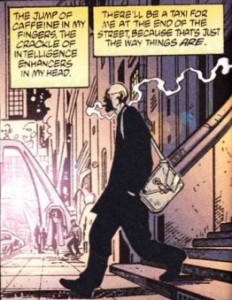 What’s interesting about Transmetropolitan is that it does and does not have a clear plot at the same time. On one hand the focus of the comic is Spider Jerusalem and his attempts to finish two books for his editor but that quickly becomes a secondary focus as this first volume spends little time establishing that plot point. Instead the primary focus falls on that of Spider Jerusalem himself, establishing his ethics and beliefs as a human being. Ellis makes a loveable jerk who hates the world but is amazing at his job, even going as far as having penciller Darrick Robertson do a bit of tongue in cheek humour with the way Spider Jerusalem looks during much of the first issue. Needless to say, he greatly resembles an incredibly talented comic writer who probably will spend millions of dollars one day on fortifying a Mountain just so he can live in peace. With Spider, you’re just as likely to fall in love with the characters message as you are to loathe him. He often leaps before he thinks, lashing out verbally without ever really stopping or regarding how his words will effect other people, creating more than a few interesting situations for the character. With all the different sensitive topics he tackles through this first volume, you can only imagine the types of trouble he encounters as a result.
What’s interesting about Transmetropolitan is that it does and does not have a clear plot at the same time. On one hand the focus of the comic is Spider Jerusalem and his attempts to finish two books for his editor but that quickly becomes a secondary focus as this first volume spends little time establishing that plot point. Instead the primary focus falls on that of Spider Jerusalem himself, establishing his ethics and beliefs as a human being. Ellis makes a loveable jerk who hates the world but is amazing at his job, even going as far as having penciller Darrick Robertson do a bit of tongue in cheek humour with the way Spider Jerusalem looks during much of the first issue. Needless to say, he greatly resembles an incredibly talented comic writer who probably will spend millions of dollars one day on fortifying a Mountain just so he can live in peace. With Spider, you’re just as likely to fall in love with the characters message as you are to loathe him. He often leaps before he thinks, lashing out verbally without ever really stopping or regarding how his words will effect other people, creating more than a few interesting situations for the character. With all the different sensitive topics he tackles through this first volume, you can only imagine the types of trouble he encounters as a result.
Collects: Transmetropolitan #1-6.
Best Character: Spider Jerusalem.
Best Line Of Dialogue/Caption: “Point of journalism is not about plans and spreadsheets, it’s about human reaction and criminal enterprise. Here the lesson begins.” – Spider Jerusalem.
Best Scene/Moment: Spider Jerusalem ends up like the rest of the world – Issue 5.
Best Issue: Issue 4. Hands down this is the most entertaining installment in this collection and it involves a rather small amount of action. A one-and-done story, Spider watches television all day and you get to watch how it rots his mind and makes him an even more despicable person than he already is. This issue has a strong message that is just as comedic as it is dark.
Why You Should Read It: The commentary Ellis provides on the world as a whole through Transmetropolitan can warrant the pricetag on this book alone. Then you’ll find yourself sticking around because of the hilarious, dark, and disturbing Spider Jerusalem. With Spider, Ellis has something to say and he says it in the most outrageous and brash way. Transmetropolitan tackles those hard hitting topics and doesn’t apologize for doing it. You know at some point during this generation there will be a comic that addresses our many complex social insecurities and problems but you’d do well to remember that Ellis’ Transmetropolitan already hit all those marks nearly two decades ago and still remains eerily relevant.
Thunderbolts Ultimate Collection
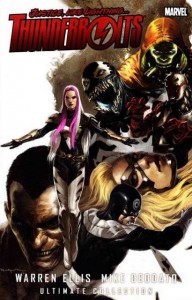 In the midst of the major Marvel event, Civil War, the superhero community was torn asunder by rivaling factions of superheroes. Warren Ellis would show what the villains were up to during this time period, working with Mike Deodato to reinvent the villainous team, The Thunderbolts, as a corporate funded team who hunted down unregistered superheroes. The series would prove to be a rather pivotal piece of the ever-changing comic landscape at Marvel, giving readers a glimpse of what was soon to come.
In the midst of the major Marvel event, Civil War, the superhero community was torn asunder by rivaling factions of superheroes. Warren Ellis would show what the villains were up to during this time period, working with Mike Deodato to reinvent the villainous team, The Thunderbolts, as a corporate funded team who hunted down unregistered superheroes. The series would prove to be a rather pivotal piece of the ever-changing comic landscape at Marvel, giving readers a glimpse of what was soon to come.
Under the guidance of Norman Osborn, an all new team of Thunderbolts is assembled in the wake of a superhero Civil War. The Civil War has left the superhero community equally divided, with the government calling for all superheroes to register their true identities so that the world can feel safer. Norman Osborn and his Thunderbolts are tasked with going out into the field and capturing any unregistered superheroes so they can be tried by the government for their “crimes”. With a Thunderbolts team full of reformed or current villains, Osborne takes this abstract and emotionally fragile cast of characters to unexpected places, being placed in charge of a group of individuals more so than a team.
Warren Ellis hits all the right notes during his Thunderbolts run, capturing the classic essence of the team while also adding his own wrinkles in with his amazing cast of characters. Simply put, Ellis’ Thunderbolts run is an unexpected instant classic, providing a much stronger story than you’d ever expect from this ragtag group of rogues. Ellis and his Thunderbolts actually serve as a prelude to some much larger things that would occur just a few short months later in the Marvel Universe, seemingly setting the table for a time period called “Dark Reign”, wherein Norman Osborn takes over S.H.I.E.L.D. and founds “The Dark Avengers”, a team of Avengers who are actually just villains in superhero disguises. Although some of the work during that era was excellent, Warren Ellis sets it all up here and it might actually be better than the amazing Bendis run of Dark Avengers.
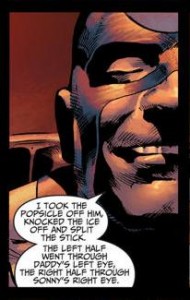 Let’s touch on the plot of this Thunderbolts collection first: in Civil War, a battle between Tony Stark and Steve Rogers over the registration of heroes and their secret identities is in full swing. The Thunderbolts, backed by Norman Osborn, are responsible for capturing any unregistered heroes still out on the streets, with these heroes being considered criminals. With that basic premise in mind, it seems like it would be incredibly simple for any writer to halfheartedly phone it in with some slack scripts and lazy plotting, just moving along until the next major Marvel event shook the status quo up. Ellis doesn’t phone it in whatsoever here, scripting out amazing action sequences (that wouldn’t work as well without the amazing artistic talent of Mike Deodato), interesting character beats and tons of insane moments that you just wouldn’t expect. From the word go Ellis seemingly skips the frying pan and throws the Thunderbolts directly into the fire. The team never actually face heroes who you’d consider part of the “Big Leagues”, instead tackling heroes like Jack Flag or Steel Spider, with the true challenge for this team falling in the range of actually trying to be a team. These psychotic and depraved Thunderbolts all have their own agendas that they try to take on when out in the field, with everyone’s personal interest always contrasting with someone else on the team. The plot frequently explores the lack of communication between the characters but is careful to not retread that territory too much, approaching the topic in different ways all the way to the end.
Let’s touch on the plot of this Thunderbolts collection first: in Civil War, a battle between Tony Stark and Steve Rogers over the registration of heroes and their secret identities is in full swing. The Thunderbolts, backed by Norman Osborn, are responsible for capturing any unregistered heroes still out on the streets, with these heroes being considered criminals. With that basic premise in mind, it seems like it would be incredibly simple for any writer to halfheartedly phone it in with some slack scripts and lazy plotting, just moving along until the next major Marvel event shook the status quo up. Ellis doesn’t phone it in whatsoever here, scripting out amazing action sequences (that wouldn’t work as well without the amazing artistic talent of Mike Deodato), interesting character beats and tons of insane moments that you just wouldn’t expect. From the word go Ellis seemingly skips the frying pan and throws the Thunderbolts directly into the fire. The team never actually face heroes who you’d consider part of the “Big Leagues”, instead tackling heroes like Jack Flag or Steel Spider, with the true challenge for this team falling in the range of actually trying to be a team. These psychotic and depraved Thunderbolts all have their own agendas that they try to take on when out in the field, with everyone’s personal interest always contrasting with someone else on the team. The plot frequently explores the lack of communication between the characters but is careful to not retread that territory too much, approaching the topic in different ways all the way to the end.
Warren Ellis creates a compelling and interesting team of Thunderbolts because of who he casts into different roles on the team. Bringing together Moonstone, Songbird, Bullseye, Radioactive Man, Venom, Penance, and Swordsman, you get such a bizarre collection of characters all falling on peculiar spots within the emotional and psychological spectrum. Ellis gives us immediate conflict between Moonstone and Songbird, having the two character vie for leadership of the team, with each woman feeling as though they can bring different elements to the role. Then you’ve got characters like Radioactive Man, Penance and The Swordsman who all have highly emotional stakes in this operation. Every member is promised a pardon and a large sum of money to complete one year of work as a Thunderbolt but with characters like The Swordsman there are more personal elements to his contract, being promised a cloned version of his dead sister. Radioactive Man has to come to terms with how the media portrays him, knowing that his appearance isn’t as lethal as the media suggests. Penance is looking for…well…penance, being directly responsible for the death of over 600 people during the event that actually kicked off Civil War and the cry for registered superheroes.
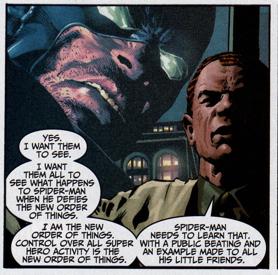 I’d classify a second part of the cast as your big time crazy characters like Bullseye and Venom, who anchor out some truly exciting moments in the story. Mac Gargan, the former Spider-Man villain The Scorpion, is the latest host for Venom and throughout Thunderbolts you watch his fight with the symbiote’s violent nature and influence. With Bullseye, Ellis crafts a character who is essentially the last line of defense. Bullseye is the man who gets the job done with general ease when no one else on the team can and seems to have way too much fun doing it. Although Ellis’ handling of these psychotic characters is truly sublime, it’s his use of the mentally unstable Norman Osborn that seemingly always steals the show. In having Norman Osborn, otherwise known as The Green Goblin, back this team, you get this sense of inevitability. You know that the Green Goblin is always lurking in the back of Osborn’s psyche, waiting to crawl out when it gets the first chance and this is something Ellis teases out beautifully throughout the entire volume. It starts out in rather minor detail but the further you go with the story, the more you see Norman’s mental state dissolve closer to becoming that of the Green Goblin’s. It’s so rich and simple, doing things like having Norman mistakenly hear the name Spider-Man or mix it up when talking about similar heroes, to suggest that the Goblin is always there. By the end of this volume, you get the sense that Ellis’ entire run was meant to build towards having the Green Goblin come through.
I’d classify a second part of the cast as your big time crazy characters like Bullseye and Venom, who anchor out some truly exciting moments in the story. Mac Gargan, the former Spider-Man villain The Scorpion, is the latest host for Venom and throughout Thunderbolts you watch his fight with the symbiote’s violent nature and influence. With Bullseye, Ellis crafts a character who is essentially the last line of defense. Bullseye is the man who gets the job done with general ease when no one else on the team can and seems to have way too much fun doing it. Although Ellis’ handling of these psychotic characters is truly sublime, it’s his use of the mentally unstable Norman Osborn that seemingly always steals the show. In having Norman Osborn, otherwise known as The Green Goblin, back this team, you get this sense of inevitability. You know that the Green Goblin is always lurking in the back of Osborn’s psyche, waiting to crawl out when it gets the first chance and this is something Ellis teases out beautifully throughout the entire volume. It starts out in rather minor detail but the further you go with the story, the more you see Norman’s mental state dissolve closer to becoming that of the Green Goblin’s. It’s so rich and simple, doing things like having Norman mistakenly hear the name Spider-Man or mix it up when talking about similar heroes, to suggest that the Goblin is always there. By the end of this volume, you get the sense that Ellis’ entire run was meant to build towards having the Green Goblin come through.
For Ellis, his truly brilliant moments all fall on his handling of his characters and the things he puts them through. As I pointed out in the previous paragraph, Norman Osborn’s battle to keep the Green Goblin at bay is just one of the many examples of what I’m talking about. Ellis does some particularly excellent work with characters like Penance, Venom, Songbird and Bullseye, giving every one of these characters some truly interesting and emotional moments. Penance struggles with all the death he caused, being regarded as a villain instead of a hero. Venom’s struggle of man vs. symbiote and how it affects him in the field. Songbird’s investment in her former role as leader. Bullseye’s mental state as a result of his health woes and battles with Daredevil. All these themes are explored brilliantly and provide you with more than enough exciting moments to keep you hooked all the way through.
Collects: Thunderbolts #110-121.
Best Character(s): Bullseye and Norman Osborn.
Best Line Of Dialogue/Caption: “You know I always wondered why super heroes wear bright colours and bold designs along with their masks. If the point is that they don’t want to be recognized, why isn’t everyone in black ski masks and padded tactical gear?” – Doc Samson.
Best Scene/Moment: Norman Osborn takes matters into his own hands – Issue 120.
Best Issue: Issue 111. I picked this issue because it’s so hard to choose the best issue from this run by Ellis. Not every issue is a home run but there are more than enough issues in this collection that could easily make the claim for being the best. Issue 111 gets the nod as it’s the first time you get to see the team in action and Bullseye steals the show late in the game with a scene that is familiar but still incredibly disturbing.
Why You Should Read It: We’ve seen teams of bad guys doing the work of good guys so many times in comics. That’s why teams like the Suicide Squad, Thunderbolts, or even the Dark Avengers exist. But Ellis’ time with the Thunderbolts examines some complex moral issues in ways that are both exciting and satisfying. It’s a great cast of good and bad guys who will all put up great arguments to be your favourite character. Ellis and Deodato redefine how to write a villain based team book with their work on Thunderbolts, placing the team together during a very interesting time period in the Marvel Universe.

